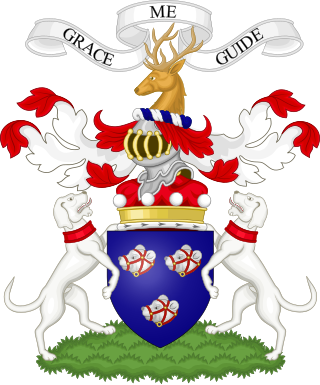Related Research Articles

John Charles Spencer, 3rd Earl Spencer,, styled Viscount Althorp from 1783 to 1834, was a British statesman and abolitionist. He was Chancellor of the Exchequer under Lord Grey and Lord Melbourne from 1830 to 1834. Due to his reputation for integrity, he was nicknamed "Honest Jack".

Duke of Montrose is a title that has been created twice in the Peerage of Scotland. The title was created anew in 1707, for James Graham, 4th Marquess of Montrose, great-grandson of famed James Graham, 1st Marquess of Montrose. Montrose was elevated as a reward for his important support of the Act of Union. It has remained since then in the Graham family, tied to the chieftainship of Clan Graham.
There are currently two earldoms of Mar in the Peerage of Scotland, and the title has been created seven times. The first creation of the earldom is currently held by Margaret of Mar, 31st Countess of Mar, who is also clan chief of Clan Mar. The seventh creation is currently held by James Erskine, 14th Earl of Mar and 16th Earl of Kellie, who is also clan chief of Clan Erskine.

The title Earl of Moray, Mormaer of Moray or King of Moray was originally held by the rulers of the Province of Moray, which existed from the 10th century with varying degrees of independence from the Kingdom of Alba to the south. Until 1130 the status of Moray's rulers was ambiguous and they were described in some sources as "mormaers", in others as "Kings of Moray", and in others as "Kings of Alba". The position was suppressed by David I of Scotland some time after his defeat of Óengus of Moray at the Battle of Stracathro in 1130, but was recreated as a feudal earldom by Robert the Bruce and granted to Thomas Randolph, 1st Earl of Moray in 1312.

Earl of Dundee is a title in the Peerage of Scotland. It was created in 1660 for John Scrymgeour, 3rd Viscount Dudhope. At his death in 1668, the Duke of Lauderdale declared that the first Earl had no heirs-male, and had the crown seize all of his lands. The earldom of Dundee became dormant and its holdings and offices were granted to Charles Maitland, 3rd Earl of Lauderdale, the Duke's younger brother. The title was revived in 1953, when it was determined that the first Earl did indeed have heirs-male, contrary to the assertion of the crown. The title was given to Henry James Scrymgeour-Wedderburn, who had previously served in the House of Commons and in the Cabinet.

Baron Clinton is a title in the Peerage of England. Created in 1298 for Sir John de Clinton, it is the seventh-oldest barony in England.

Lord Forbes is the senior Lordship of Parliament in the Peerage of Scotland.

Lord Sempill is a title in the Peerage of Scotland. It was created in circa 1489 for Sir John Sempill, founder of the collegiate Church of Lochwinnoch. Sempill was killed at the Battle of Flodden in 1513. His grandson, the third Lord, was known as "The Great Lord Sempill". His grandson, the fourth Lord, was Ambassador from King James VI of Scotland to Spain in 1596. The male line failed on the death of his great-grandson, the eighth Lord, in 1684. He was succeeded by his sister Anne, wife of Robert Abercromby, who in 1685 was created Lord Glassford for life. In 1688 she obtained a new charter settling the lordship of Sempill in default of male issue, upon her daughters without division by her then and any future husband. Her younger son, the twelfth Lord, commanded the left wing of the government army at the Battle of Culloden in 1746.

Earl or Lord of Clanricarde is a title that has been created twice in the Peerage of Ireland, first in 1543 and again in 1800. The former creation became extinct in 1916 while the 1800 creation is extant and held by the Marquess of Sligo since 1916.

George Hay, 7th Marquess of Tweeddale DL was a Scottish peer and naval officer.
There have been two baronetcies created for persons with the surname Adam, both in the Baronetage of the United Kingdom. One creation is extant as of 2009.
There have been five baronetcies created for people with the surname Forbes, four in the Baronetage of Nova Scotia and one in the Baronetage of the United Kingdom. The first holder of the Burn baronetcy of Jessfield, created in the Baronetage of the United Kingdom in 1923, assumed the surname of Forbes-Leith of Fyvie in 1925.
William Douglas, 9th Earl of Angus was a Scottish nobleman and zealous supporter of Mary, Queen of Scots.

Clan Forbes is a Highland Scottish clan from Aberdeenshire, Scotland.

William Forbes-Sempill, 17th Lord Sempill, born William Forbes, was a Scottish peer, the 17th Lord Sempill and 8th Baronet of Craigievar.

William Keith, 4th Earl Marischal was a Scottish nobleman and politician.

Sir Charles Forbes, 1st Baronet (1774–1849) was a Scottish politician, of Newe and Edinglassie, Aberdeenshire. Forbes was the son of the Rev. George Forbes of Lochell. He was a descendant of Alexander Forbes of Kinaldie and Pitsligo, and was in 1833 served heir male in general to Alexander Forbes, 3rd Lord Forbes of Pitsligo, father of Alexander Forbes, 4th Lord Forbes of Pitsligo, attainted in 1745.
Events from the year 1687 in Ireland.

Corse Castle near Lumphanan in Aberdeenshire, now ruined, was a fortress and centre of a landed estate in the north-east of Scotland. The present castle dates from the 16th century and stands by the Corse Burn, around 3 miles north-west of Lumphanan.
John Cochrane, 4th Earl of Dundonald, was a Scottish aristocrat and politician.
References
- ↑ John Burke A General and Heraldic Dictionary of the Peerage and Baronetage of the British Empire, by John Burke Esq, 1832, H Colburn and R Bentley, London